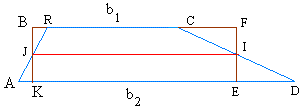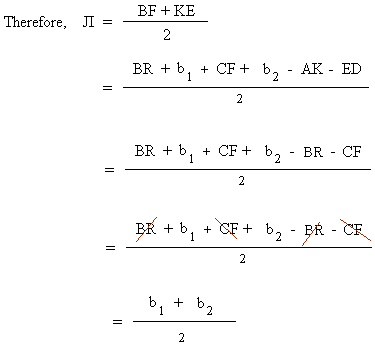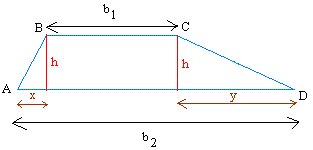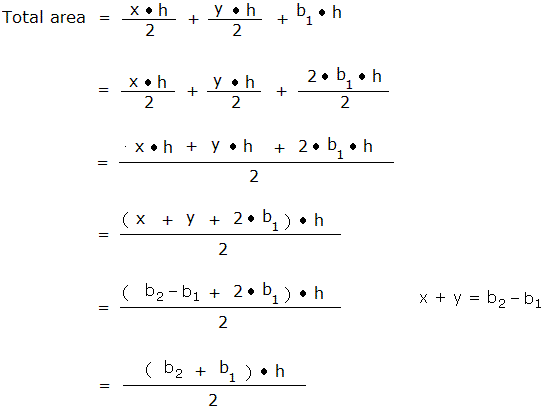Proof of the area of a trapezoid
A first good way to start off with the proof of the area of a trapezoid is to draw a trapezoid and turn the trapezoid into a rectangle.

Look at the trapezoid ABCD above. How would you turn this into a rectangle?
Draw the average base (shown in red) which connects the midpoint of the two sides that are not parallel.

Then, make 4 triangles as shown below:

Let's call the two parallel sides in blue (the bases) b1 and b2
Triangles EDI and CFI are congruent or equal and triangles KAJ and RBJ are congruent or equal. Therefore, you could make a rectangle by rotating triangles EDI around point I, 180 degrees counterclockwise and by rotating triangle KAJ clockwise, but still 180 degrees around point J.
Because you could make a rectangle with the trapezoid, both figures have the same area.
The reason that triangle EDI is equal to triangle IFC is because of ASA. We can find two angles inside the triangles that are the same and the side between the angles is the same for both triangles.
The angles that are the same are shown below. They are in red and green. The angles in green are right angles. The angles in red are vertical angles.
 |
This is important because if these two triangles are not congruent or the same, we cannot make the rectangle with the trapezoid by rotating triangle EDI. It would not fit properly
Again, this same argument applies for the two triangles on the left
Therefore, if we can find the area of the rectangle, the trapezoid will have the same area.
Let us find the area of the rectangle. We will need the following figure again:
 |
First, make these important observations:
b1 = RC
BF = BR + b1 + CF
b2 = AD
KE = AD − AK − ED, so KE = b2 − AK − ED
AK = BR and ED = CF
Notice also that you can find the length of the line in red ( the average base ) by taking the average of length BF and length KE
 |
Since the length of the line in red is the same as the base of the rectangle, we can just times that by the height to get the area of the trapezoid.
Finally, we get :
 |
An alternative proof of the area of a trapezoid could be done this way.
Start with the same trapezoid. Draw heights from vertex B and C. This will break the trapezoid down into 3 shapes: 2 triangles and a rectangle. Label the base of the small triangle x and the base of the bigger triangle y
Label the small base of the trapezoid b1 and b2
 |
b1 = b2 − ( x + y), so x + y = b2 − b1
The area of the rectangle is b1 × h, but the area of the triangles with base x and y are :
|
|
To get the total area, just add these areas together:
 |
The proof of the area of a trapezoid is complete. Any questions, contact me.